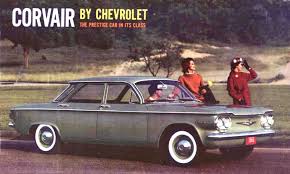The Car that CHANGED THE HISTORY OF EVERYTHING EVER

April 30, 2020
Many companies have had their monumental “flop” where a bit of bad press had the whole world ready to dispose of them. Coca-Cola with their New Coke, Windows with Microsoft Bob, or even Cosmopolitan branded yogurt (wat). None of these, however, trump the absolute beating that young lawyer Ralph Nader bestowed upon the American auto-manufacturer Chevrolet, and their quirky little car, the Corvair.
In the year 1960, America was booming. Cities were going up like rockets, and cars were being thrown off of the assembly line like rocks from behind a digging dog. With city streets getting narrower and cars becoming more plentiful, Chevrolet saw an opportunity for a compact, efficient, and easy-to-make car for the masses. So where did they turn for inspiration? 
Germany. At the time, the Volkswagen Beetle was selling all over Europe like TP in an epidemic. So the savvy folks down at Chevrolet started thinking that they should get in on that action. Enter, the Chevy Corvair.
With the same rear suspension and air cooled engine design as the Beetle, Chevy got to work “american-ifying” it. This involved making the car bigger and adding in a bigger motor (you know, because Americans are chonky). Their engine of choice was a freshly developed flat-6. For reference as to how crazy this is, all engines in cars nowadays are liquid cooled and almost all have inline cylinders or cylinders in a V formation. What Chevy was doing in the Corvair was cylinders that were opposing each other, and doing it all without liquid cooling. For the cherry on top, Chevy also decided to slap this creation into the TRUNK of their new car.
They utilized the same “swing arm” rear suspension as the Beetle, which means that as the rear wheels move through their travel, they pivot on a single axis–meaning that the camber of the wheel changes as it travels. For those who have no idea what I am talking about, basically, it’s hekin sketchy.
This was a design that worked well for the slow, city-going Beetle. However, with American highway speeds surpassing 70mph, the Corvair became a flipping mess. Numerous accidents involved Chevy Corvairs losing control and rolling over due to the lazy rear suspension design. By the mid 1960s, the car was starting to lose some of its shine, despite having sold over 200,000 units in each of its first six years of production.
Enter Ralph Nader, a kid who was fresh out of law school and looking for adventure. He decided to hitchhike across America, and was going to stop and get a job wherever he felt like it. After about a month of traveling, Nader decided to stop this “madness” and got straight to work–not as a lawyer but an author.
In his roughly 30 days of traveling, Nader had almost been involved in “…10 too many accidents…” And upon his arrival, he had decided to devote himself to changing the safety standards inflicted on American cars. His book, published in 1966 was titled Unsafe at Any Speed-The Designed-in Dangers of the American Automobile, and its primary target was the Chevy Corvair. Unsafe at Any Speed, went on to be a New York best seller and a gun to the head of all American auto-makers.
In 1966, the second iteration of the Corvair was also released; this time with a new rear suspension that was safe at any speed and all but eliminated the risk of rollovers. But Nader’s book had permanently soiled the name and idea of a rear engined American car. So, in 1969 (nice), and after nine years and 1.4 million cars sold, the Corvair name was retired.
While other companies have lost a fortune on products that were truly horrible, I think Chevy took a fall that was further than it needed to be. They understood the problem with their car and fixed it, even if it did take six years.
What Ralph Nader’s book did was change the course of history forever. It showed the public what was really happening in the inner workings of American auto-makers. And it showed that cars truly were commuting death traps. Nader’s book helped to bring to light what would have otherwise been a continuing problem that would result in hundreds of thousands of deaths. So even if it cost us one of the cutest and quirkiest cars ever to come out of Detroit, it was worth it.





